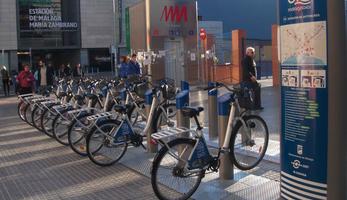PROMOTION OF CYCLING: PUBLIC BICYCLE SCHEME IN MALAGA
Summary
The measure will consist in introducing a public bicycle scheme in the City of Malaga, combined with public transport. It will help to increase the share of bicycles in the modal split, by complementing the existing bicycle lanes and infrastructure.
Implementing sustainable mobility
The city of Malaga already counts with a bicycle lanes network of around 30 km, but cycling represents just 0.4% within the total modal split. Nevertheless, due to the recent creation of the first bicycle lanes and parking network, it is forecasted a gradual increase of cyclists in the next years.
The introduction of a public bicycle scheme will reinforce the current measures implemented by the municipality for cycling, contributing to promote bicycle as an alternative and competitive means of transport comparing with private motorized vehicles, and increasing the whole number of cyclists in the city..
This measure offers to citizenship an alternative to private vehicles, especially in their short and mid distance daily trips.
It is planned to implement a total of 20 stations. In addition, original types of locking screws and identification stickers are being used for each bicycle; the latest technological solutions have been implemented in order to manage the public system for bicycle registration, identification, access modality through magnetic cards, as well as for the information processing of users modalities (hours, periods and itineraries of more frequent use, etc.). Especially, the magnetic card to access the bicycle system is the same used by public buses users, as the system will be managed by the Malaga municipal transport company, EMT-SAM.
The system is available not only for citizens of Malaga, but also for tourists, through designing specific solutions and formulas for short term users.
Other specific segments of the general population could be targeted as well with personalized facilities.
Progress
At the moment, the following studies have been already carried out:
- a cycling mobility study within the city of Malaga, including bicycle modal split analysis and a survey to a representative sample of users of different modes of transport (car, public transport, pedestrians, bikers) concerning their attitude and preferences regarding cycling;
- a technical study concerning the type of system to install, the location of the stations, the features of the bikes to rent, as well as a benchmark with other case studies of other public bicycle schemes already successfully implemented in Spain;
- a study on the complementary services to be associated to public bicycle scheme, such as rates, payment and access modalities.
The system was inaugurated on 29th July 2013 in a public act with the presence of the Mayor of Malaga and representatives of the Spanish National Authority on Traffic regulation. At that time the first four stations entered into service. One year later, the 28th July 2014, the last station was inaugurated, so the system, which consists of 20 stations with 600 bicycle stands or ‘derbies’ and 400 available bikes, is now fully implemented.
The follow up of the system is being carried out by controlling its correct operation and through obtaining monthly statistical data about usage by the technical tools used to run the system (software, card readers, etc). Among the most relevant data obtained: number of users, frequency of use, most frequent itineraries, etc.
Outcomes
The measure is directly linked with the Malaga Sustainable Urban Mobility Plan main objectives, which aims to promote cycling as a clean and healthy mode of transport by taking advantage of the favourable weather and physiographic conditions of the city.
The strategic objectives of the Malaga SUMP linked to cycling are:
- to reduce emissions and energy consumption linked to private motorized vehicles traffic,
- to strongly reduce the total annual motorized trips and mileage in the inner city,
- to promote intermodality between bicycles and public transport,
- to raise awareness among citizens of the benefits of cycling,
- to promote a greater use of bicycle routes, expanding the use of bicycles in the urban area as a means of transport in coexistence with motor vehicles.
The main concrete objective linked to the measure implementation is to increase the percentage of bicycle in the modal split to 4.0% in 2016., especially encouraging the use of cycling for home-school and home-work trips.
The citizens’ acceptance of the public bike scheme is significant: for the first year of operation, 17,000 people have subscribed the service and it is estimated that every bike is used 8 times a day.







